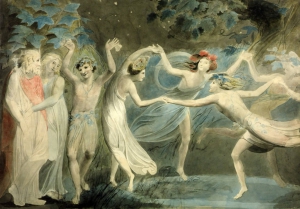Midsummer madness? Disruptive innovation in higher education
Midsummer is traditionally a time for kicking over the traces and stepping outside convention, as with the fairy mischief depicted in William Shakespeare’s A Midsummer Night’s Dream.
As Midsummer Day has just passed, it seems appropriate to look at a higher education model that deliberately upsets the status quo in order to find new, creative ways of teaching and learning.
“Be not afraid of digitality.” – Professor Sheena Gardner, Head of the Department for English and Languages at Coventry University
The theory of disruptive innovation was first promoted by Harvard professor Clayton M. Christensen in his 1997 book The Innovator’s Dilemma. It relates to commercial markets, and describes how the market for a complicated, expensive product can be turned upside down by the introduction of a product which is simple, convenient, accessible and affordable.
An example of disruptive innovation in the commercial world is the development of personal computers. Originally the market consisted of mainframes and minicomputers, which were beyond the means of and too technical for ordinary individuals. With the introduction and development of smaller, more affordable personal computers, the industry was revolutionised.
“It’s important to remember that disruption is a positive force. Disruptive innovations are not breakthrough technologies that make good products better; rather they are innovations that make products and services more accessible and affordable, thereby making them available to a much larger population.” – Clayton M. Christensen
Disruptive practice in higher education
Academics at Coventry University (CU) believe that, in a rapidly changing world of mobile electronic devices and global connectivity, universities need to apply disruptive innovation to existing ways of teaching and learning so that new practices can emerge.
At the launch of the CU Disruptive Media Learning Lab, Co-Director Shaun Hides commented:
“In an increasingly connected world academics are no longer the sole source or foundation of higher level knowledge so universities need to respond to this new reality.…at the heart of our approach is a desire to ensure that our students are properly equipped to study topics that are rapidly changing and evolving. By widening the sources and types of knowledge from which students can draw, we’re also better preparing them for the types of working environments that they will encounter across the globe.”
Disruptive learning techniques include using mobile devices, open source software and collaborative web tools, as well as Massive Open Online Courses (MOOCs). They give learners autonomy, in that (to an extent) they can choose how and when to learn. Digital technologies are harnessed to create learning apps and encourage learners’ creativity, allowing them to publish online, creating content for a wider audience.
CU Coventry’s Uni@Work programme, a revolutionary concept which delivers higher education entirely in the workplace, is a disruptive innovation in itself. It inverts the traditional model for study alongside a full-time job, where employees attend classes in educational establishments at night and/or weekends. Instead, Uni@Work’s higher education programmes, including Degree Apprenticeships, are tailored to the unique business needs of each employer, as well as to the individual learning needs of their employees, who are able to apply what they learn to their own work areas from day one.
